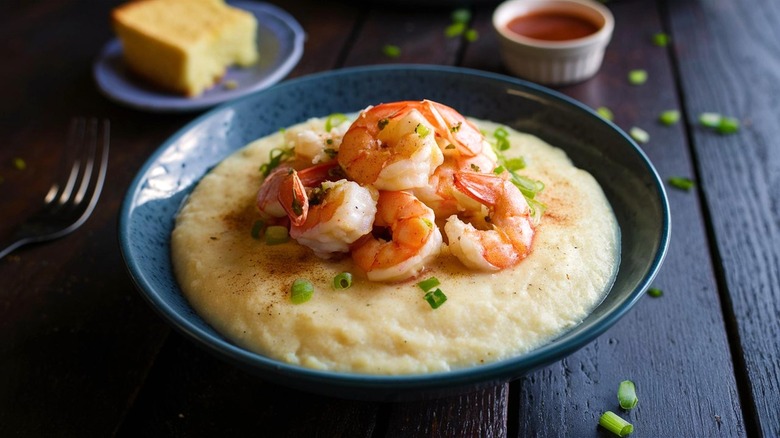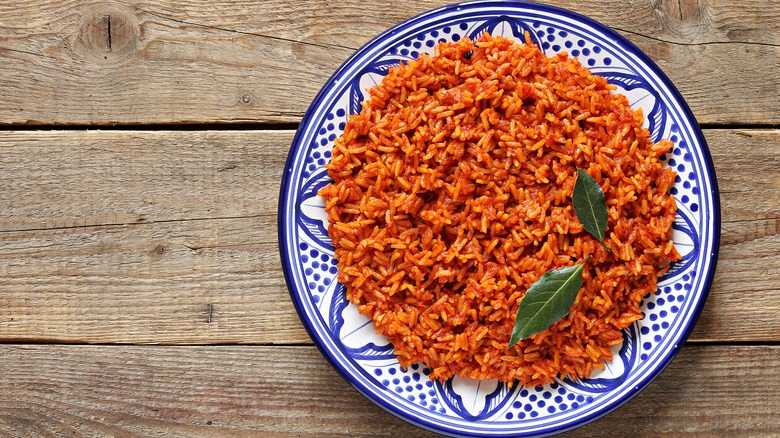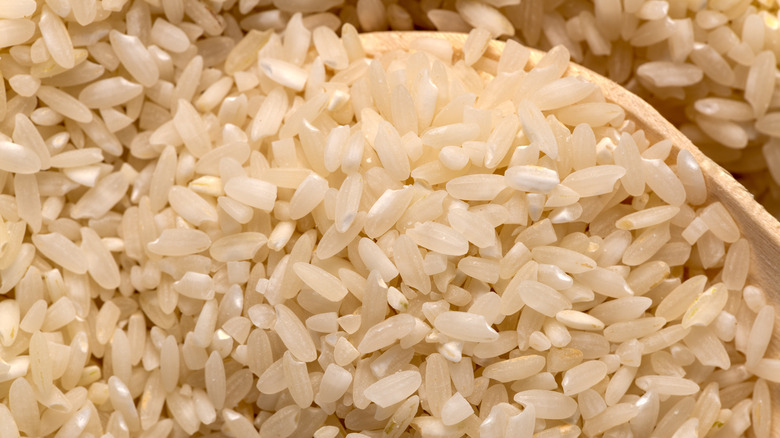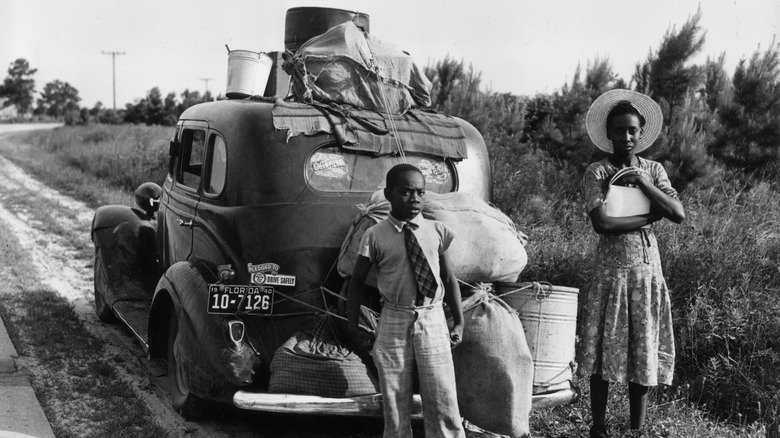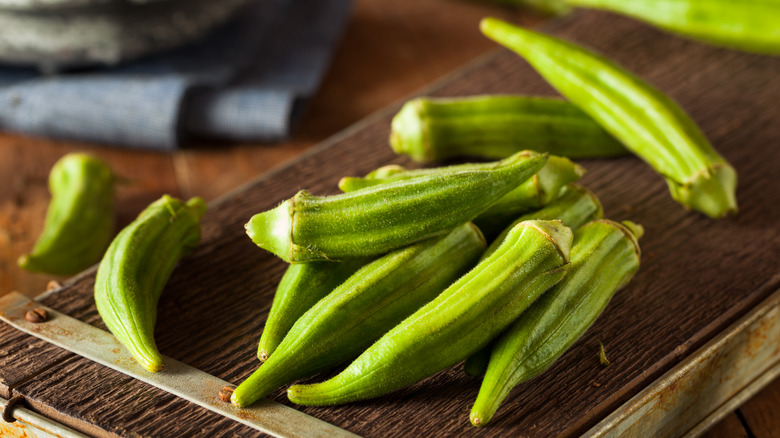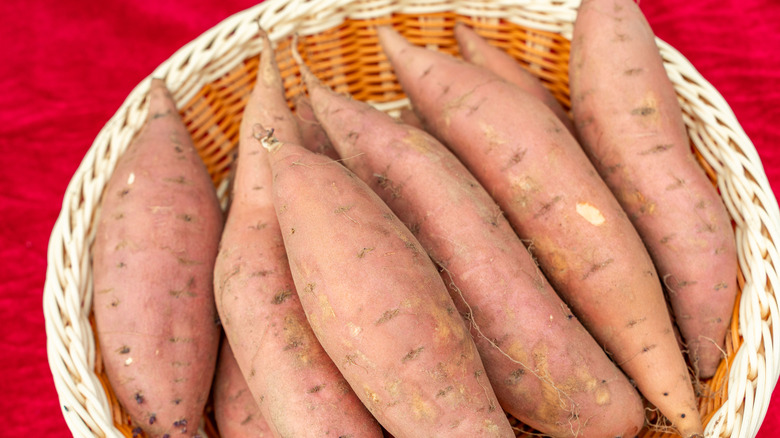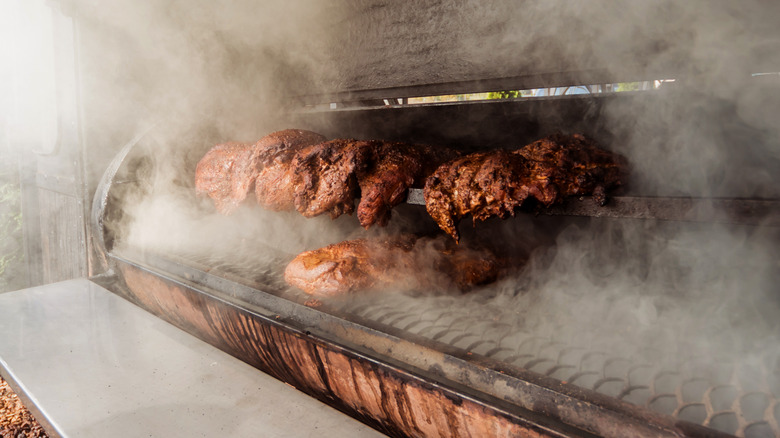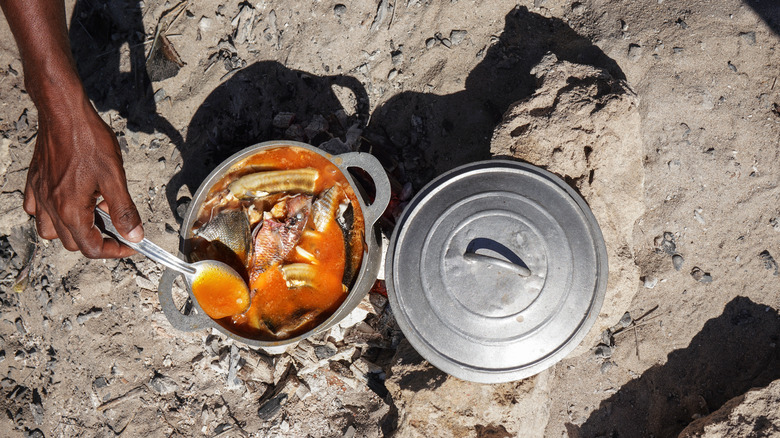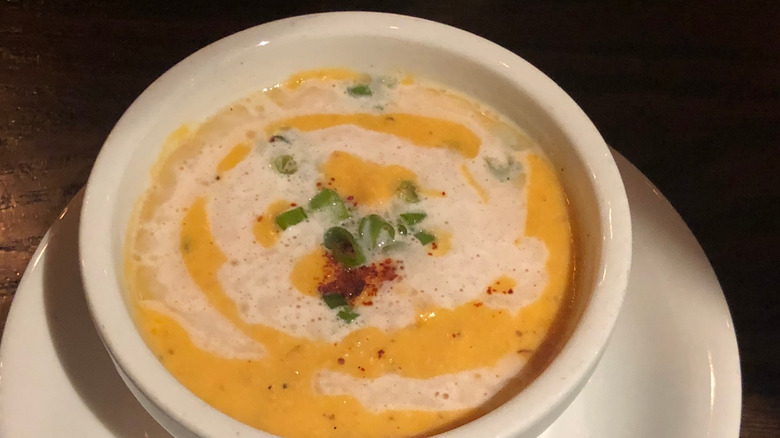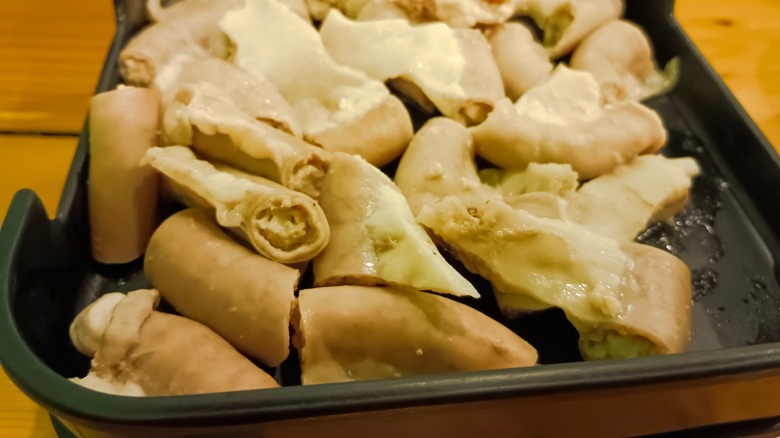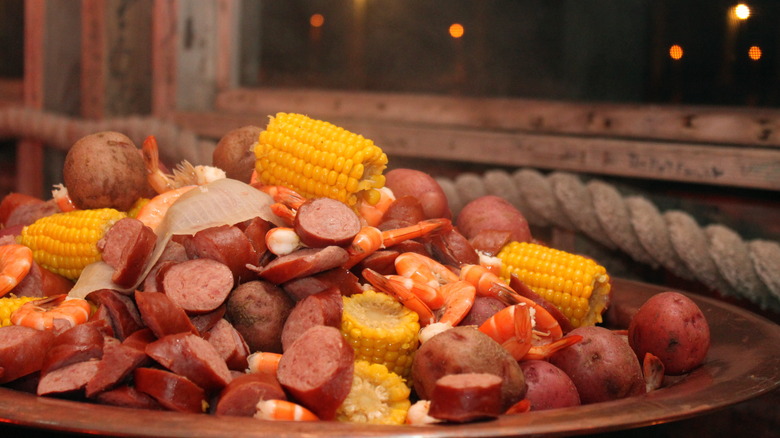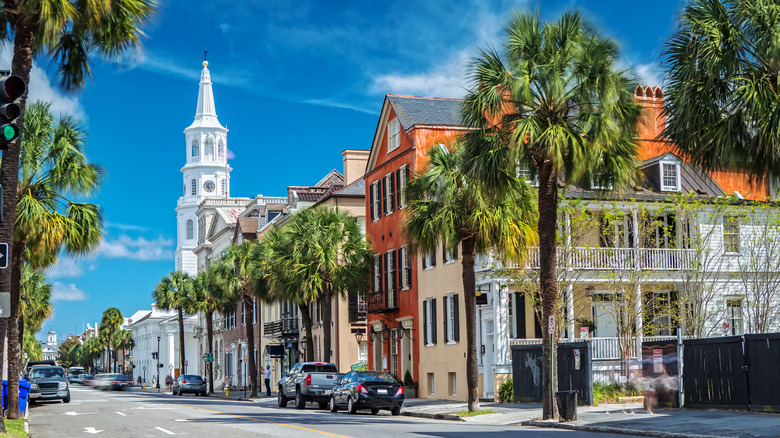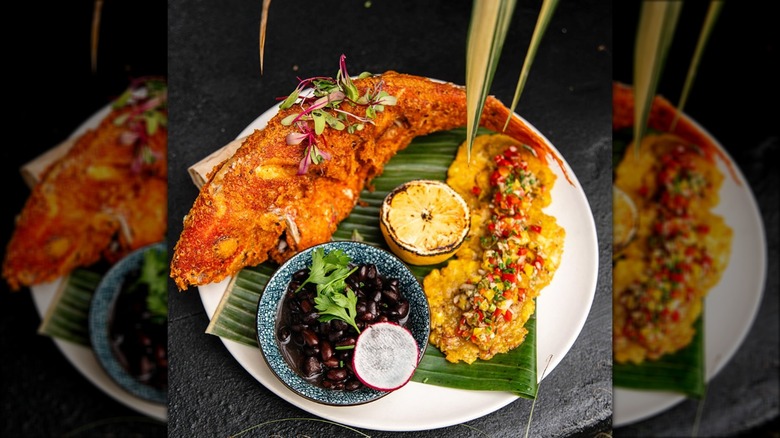Gullah Cuisine And Its Role In Southern Food History
We may receive a commission on purchases made from links.
Southern food is often viewed as a monolith, a single type of cuisine that was uniformly developed long ago. In reality, the term 'Southern food' is more of an umbrella under which numerous geographically linked food cultures and cuisines continue to thrive. While many cuisines influence Southern food and cooking, few have been as impactful as Gullah cuisine, the food of the Gullah — also known as Gullah Geechee — people.
As Gullah chef and educator Benjamin 'BJ' Dennis explained to Charleston City Paper, "Gullah cuisine is the Queen Mother of Lowcountry food." Yet despite being responsible for many of the South's most popular dishes — and indeed, several characteristics that make this entire region's food stand out — Gullah cuisine has often not been given the full credit it is worthy of for its significant culinary traditions.
However, Gullah cuisine is starting to get the recognition it deserves. In Southern cities such as Charleston, South Carolina, Gullah cuisine has been increasingly acknowledged in recent years, while several Gullah cookbooks are educating Americans across the country about the culture's impact on Southern food history. In this article, we attempt to contribute to this educational process by providing some information about the huge impact Gullah cuisine has had on Southern food over centuries.
Gullah cuisine draws from multiple African cuisines
Gullah culture began when enslaved people with diverse backgrounds of West and Central Africa were forced to work together on remote coastal plantations spread across islands in the southeastern part of what is now the United States. Over time, these disparate groups of Africans formed a new culture and language.
This process was made possible by the isolation of these enslaved people. Thanks to a geographic location largely separated from the mainland, and the constant threat of diseases like malaria and yellow fever that were prevalent around swampy grounds, white plantation owners tended to avoid these cultivation areas, allowing the workers to retain important traditions of their African culture.
With minimal contact to the outside world, Gullah culture developed and continued to draw heavily on the peoples' African roots. This was and is apparent in Gullah cuisine, with many dishes being similar to customary African foods. One example is red rice, a classic of Gullah cuisine that has many similarities with jollof rice, a hugely popular dish in West Africa. Although the two dishes are distinct, many chefs — including Bintou N'Daw and Brooks Harrison — note that red rice is clearly similar to jollof rice, and point out that this is just one of the many links Gullah food has to various African cuisines.
The Gullah people established rice dishes in the Lowcountry
Rice plays an integral role in Gullah cuisine, and it's been this way ever since enslaved Africans were first forcibly transported to America's coastal plantations. Many of these individuals came from a region of West Africa called the Rice Coast, and they brought along an incredible understanding of the crop. It's been recorded that rice plantation owners specifically sought enslaved laborers from the Rice Coast because of their expertise.
Colonists found that coastal areas of the Carolina region — called the Lowcountry — were ill-suited to growing grains like wheat and barley, but the swamplands could be manipulated for cultivating rice, a process fostered by the agricultural knowledge of the Gullah people. As a result, varieties of this grain — including Carolina Gold rice — became a pillar of Gullah cuisine, and remains so today through dishes such as red rice.
Largely due to the expertise of the Gullah and other enslaved Africans, rice soon became a vital part of the culinary culture in the Lowcountry and across the South. This has remained the case over generations, marking this as one of the Gullah culture's largest impacts on Southern food.
The cuisine spread across the U.S. after emancipation
Due to their location along the southeastern islands of the United States, the Gullah people experienced extended periods of isolation, both during and after slavery. As a result, they developed a unique culture based on their geographic location and African heritage. This culture remains strong today, with the Gullah Geechee people being an internationally recognized nation with a distinct language, set of traditions, and cuisine. However, Gullah culture and cuisine is not limited to the Southeast's Gullah Geechee Cultural Heritage Corridor, stretching along the coast from North Carolina to Florida.
During the Great Migration (the period spanning from the early 20th century through the Civil Rights Movement and beyond, when approximately 6 million African Americans moved out from the South in an attempt to escape the area's racial violence and lack of opportunity), Southern cuisine was spread across the nation. By this time, Gullah cuisine had already imparted a huge influence on Southern food, and as a result, the movement of these people — even those without direct ties to the Gullah community — resulted in the mass dissemination of Gullah culinary practices and dishes. This is a major reason why certain Gullah dishes are now a part of the country's nationwide food culture.
African ingredients play a key role in Southern food
Rice is just the tip of the iceberg when it comes to ingredients that were brought over, cultivated, and popularized by African ancestors of the Gullah people. Across the South, every refrigerator needs a jar of pickled okra in it — and okra is one of many ingredients with African origins, along with yams, watermelons, and black-eyed peas. These foods and other ingredients with African roots are used in Gullah cooking, and they play an enormous part in Southern cuisine.
Initially, these African ingredients were cultivated because they were well-suited to the area's local climate, and were foods that the enslaved populace was accustomed to growing; before emancipation, many enslaved people supplemented their rations by growing their own fruits and vegetables. These ingredients — and the dishes made with them — were soon being consumed by people across the South, and were featured in cookbooks. While Black cooks were left uncredited in these cookbooks, African ingredients played a central role in recipes published from as early as the 1800s.
Nowadays, many ingredients introduced and cultivated by the Gullah people are recognized as an integral part of Southern food, and are celebrated nationwide. As food historian Kevin Mitchell highlighted to Charleston City Paper, "Ingredients [from Africa] have had a huge impact on how we eat and what we eat."
Gullah influence helps inspire Southern cooking's growing emphasis on seasonality
Thanks to the South's conducive climate for growing food, the Gullah people have access to an impressive bounty of fruits and vegetables all year round, and seasonality remains a huge aspect of Gullah cuisine. As Gullah chef Bill Green said to travel writer Adrienne Jordan, "Gullah cooking is about cooking by the seasons," noting that nature's bounty is ideal for timely health. "In the summer, the seasonal okra, beans, and tomatoes help to build up your strength and body for the fall," Green adds.
Gullah cuisine's emphasis on seasonality was borne from necessity, with past generations not having access to a wide variety of fresh produce in the same way that many Americans do today. But while the majority of Americans no longer need to eat seasonally, Southern food in general continues to spotlight fresh, local ingredients, thanks in part to the precedent set by Gullah cuisine.
Slow-cooking and other techniques were popularized by Gullah cuisine
The rich flavors associated with Southern cuisine are partly attributable to the popularity of two culinary techniques common in the region: smoking and slow-cooking. Numerous groups used smoking to preserve food in this part of the country, including Native Americans and the Gullah, whose forebears had a history of smoking foods in Africa.
It is thought that, over generations, African and Indigenous smoking methods melded together to form the modern smoking techniques that play a huge role in all types of Southern cooking today. Paramount among these, barbecue traces an unbroken line of Black culinary history. The prevalence of smoking in the Gullah community is demonstrated by the inclusion of smoked meats in many of the culture's most popular dishes, including red rice and collard greens.
While smoking essentially began as a means of meat preservation, slow-cooking was utilized by the enslaved Gullah for the simple reason that it was one of the only ways they could prepare food for themselves with scarce cooking implements and while carrying out their grueling work schedule. A pot of food could be put over the fire before starting work, where it would cook slowly throughout the day, and be eaten once the work was finished. Aside from being practical, these slow-cooked dishes were also delicious, and many are still made today.
Gullah cuisine played a role in the popularity of one-pot dishes
Enslaved workers were frequently only provided with the bare minimum of what they needed to survive. This was as true for cooking equipment as it was for ingredients, and as a result, many communities of enslaved people had to make do with only a single pot to cook with. Such limitations often meant that the Gullah people routinely cooked one-pot meals with origins in West Africa, such as gumbo stew or rice-based perloo. Slow-cooking this type of dish also allowed the enslaved individuals to make the most of their often-meager meat rations, as simmering tough cuts helps them become tender.
Anyone who is familiar with Southern cooking will know that one-pot dishes continue to form a huge part of the region's cuisine, with dishes like gumbo and jambalaya remaining immensely popular. As such, this is another way that the culinary practices of Gullah people continue to influence Southern food to this day.
Gullah cuisine inspired a lot of Southern cooking to focus on seafood
Thanks to the popularity of barbecue in the region, Southern food is perhaps most closely associated with pork. That being said, the region's food also places great emphasis on the use of local and seasonal seafood, through dishes like shrimp and grits and she-crab soup.
The proximity of an extensive coastline is the main reason why seafood plays a huge role in foods of the South. Making the most of all food sources available to them, the Gullah and other people in the region with African heritage came up with a great many ways to use this natural bounty. Shrimp, oysters, crab, and other seafood all play a fundamental role in prominent dishes of Gullah cuisine.
Today, many of these Gullah seafood-based dishes have been adopted by the wider Southern community, or have provided inspiration for other Southern dishes. Take shrimp and grits, for example. This widely popular dish is known to have its origin in Gullah cuisine, but it's now considered as a classic of all Southern foods.
The history of slavery still affects the perception of some Gullah and Southern foods
Southern food today is full of dishes created, prepared, and championed by Black people for generations. Over time, many of these dishes have been derided, then sampled, and finally celebrated. While dishes like gumbo, shrimp and grits, and fried chicken are viewed as incredibly important components of American food culture, several other dishes and ingredients continue to be stigmatized due to their historical association with the South's impoverished Black populace. While raising and selling watermelon helped boost Black freedom following emancipation, this association has been used by racists to oppress African Americans, with negative connotations that continue to this day.
Some foods that were frequently given to enslaved people as castoff ingredients — such as pig intestines, called chitterlings or chitlins — have also been subject to expressions of racism, but are now being rediscovered. As culinary historian Michael Twitty explained to Shondaland: "In France, chitlins are considered a delicacy, but when you come to the South, it's associated with poor Black people who were enslaved by white people." However, the negative perception of such foods may change over time, especially as the culinary specialties of communities like the Gullah are receiving more positive attention.
Gullah cuisine is responsible for many famous Southern dishes
A variety of cooking techniques and ingredients have been introduced into the wider realm of Southern food by the Gullah people. However, for those living outside of the area and who do not often cook the region's classic foods, the Gullah's impact may best be appreciated by measuring another metric: how many popular Southern dishes have been introduced by the Gullah people.
Over the centuries, the Gullah people have contributed numerous recipes to Southern food's canon. These include the aforementioned red rice and shrimp and grits, along with other specialties like conch stew, Lowcountry boil, and hoppin' John, a classic dish that brings good luck. Many such specialties are detailed in Emily Meggett's celebrated cookbook published in 2022, "Gullah Geechee Home Cooking: Recipes from the Matriarch of Edisto Island" — released when the author was in her late 80s. A growing collection of other cookbooks are also dedicated to Gullah cuisine.
Charleston's dining scene has been especially shaped by Gullah cuisine
More than any other city in the United States, Gullah cuisine has shaped the dining scene of Charleston, South Carolina — a city that was notably highlighted in one of the essential episodes of "Parts Unknown" with Anthony Bourdain. This coastal community has been fueled by Gullah cooking for centuries, and many of its iconic dishes — including shrimp and grits — have a direct link back to the Gullah people. Despite this, proper credit has not always been given to the Gullah for their involvement in the city's celebrated cuisine.
In recent years, the culinary contributions of countless Gullah people have been more widely spoken about and acknowledged in Charleston. While some community members express concerns about the motivations behind this renewed focus on the Gullah culture — including suspicions of cultural appropriation for financial gain — there is a growing understanding that the city's rich culinary reputation was, and continues to be, built upon the unique influences of Gullah people. While this is not enough to right the wrongs of the past, many people believe it's a good start.
Gullah culture is one of several that influence Southern cuisine
While Gullah cuisine has had an outsized influence on Southern food, it is not the only culture to have an impact. In recent years, dishes of the South have been creatively altered with Hispanic and Asian culinary styles, in addition to those of people from other cultures, as many immigrants continue to make this part of the United States their home. The expertise, knowledge, and preferences brought to the area by newly arrived people are causing Southern food to evolve before our eyes, with dishes such as collard green tamales becoming a common feature on the region's menus.
These novel influences do not mean that the impacts of Gullah cuisine will be diminished, but instead indicate that a new era is beginning when these multicultural culinary traditions will be embroidered with different skills, ingredients, and dishes. As food writer John T. Edge said to NPR, "A new, kind of 'future-tense South' is at hand, and it is in the hands of immigrants — Southerners, first-generation Southerners."
